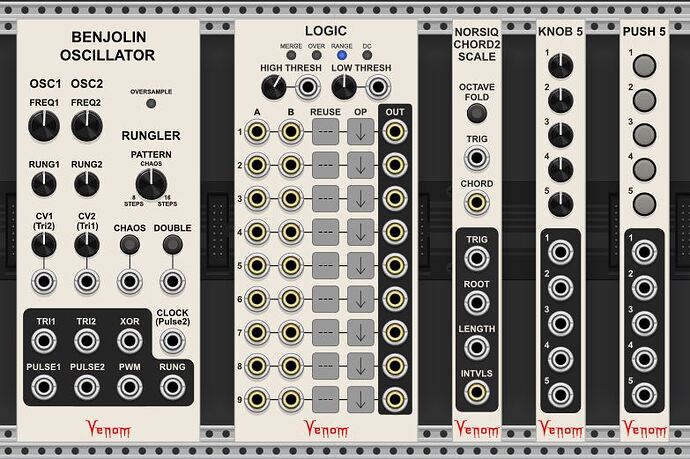I think I have my next release of Venom fleshed out, and I would love if some people test it out before I submit to the library. Obviously I want to fix any bugs that might crop up, but I am also open to suggestions for improvement.
Newest stabile binaries with new Widget Menu Extender module are here
First appearance of Poly Sample & Hold Analog Shift Register is here
Original outdated Venom v2.6beta binaries available here
Global Enhancement
There is one major enhancement for the entire plugin - all Venom controls and ports now have a context menu option to set a custom name. The custom name does not appear on the faceplate, but it does appear in the hover text and context menus - great for verifying you have the correct control before you twist a knob, or for tracing patches.
There are 5 new modules
Benjolin Oscillator
A complex chaotic oscillator emulating the oscillator and Rungler components of a Benjolin. Simply pair the Benjolin Oscillator with a resonant filter such as the Vult Unstabile, and you have a complete functioning Benjolin.
Benjolin Oscillator Documentation here
This is my favorite of the new modules. I already had a good emulation of the Benjolin using pre-existing modules, and it sounds great. But my emulator was unable to control aliasing introduced by the Rungler. This was typically not an issue, but aliasing would crop up when clocking the Rungler at high frequencies. This new Venom module allows me to oversample the Rungler timing and thus get anti-aliased Rungler and XOR outputs. So now all outputs can have anti-aliasing, allowing the oscillator to create sweet sounds even at extreme frequencies. (No worries - it still can create harsh sounds as well, just as it should!)
The patch and video below hardly scratches the surface of what a Benjolin can do. But it does show how easy it is to patch up a fully functioning Benjolin with this oscillator, and I really like the autogenerative “song” in the video. The top dark row is a complete stand alone Benjolin. The bottom light row provides some additional modulation and effects.
Double Venom Benjolin.vcv (5.4 KB)
Logic
Flexible logic gate processor suitable for both CV and audio applications.
This is something I have been wanting for a long time. There are already plenty of options for performing AND, OR, XOR, NAND, NOR, XNOR, NOT operations. But unlike all the others, this module can control aliasing via oversampling, making it ideal for audio applications.
Other nice features include options for many more than two inputs, ability to merge polyphony into multiple inputs to a single logic gate, and ability to reuse a prior gate output in another computation without introducing sample delays. So you can create compound logic like (A and B) or C and easily keep the input signals aligned perfectly.
NORSIQ Chord to Scale
Converts up to 14 channels of a polyphonic “chord” input into a set of CV outputs that define a scale for the Non-Octave-Repeating Scale Intervallic Quantizer (NORSIQ).
NORSIQ Chord to Scale Documentation here
I believe when pairing this new module with my NORSIQ it provides very similar functionality to the SIM Coerce module. However Coerce does not work great with scales that don’t fold at one octave. It either forces all chords into octave repeating, or else restricts the quantized notes to the range of the input “chord”.
NORSIQ Chord to Scale works great with extended chords, allowing them to be turned into non-octave repeating scales so the quantizer works with notes outside the range of the input.
KNOB 5
Five independently configurable constant voltage knobs.
Each knob can be configured for different voltage ranges.
The Venom parameter rename feature works great with this module.
PUSH 5
Five independently configurable push buttons
Each button has multiple configuration options:
- Mode: Trigger, Gate, or Toggle
- On and Off output voltages: 10, 5, 1, 0, -1, -5, or -10
- On and Off button colors: All the primary and secondary colors (bright and dim), plus white, gray, and off
The Venom parameter rename feature works great with this module










